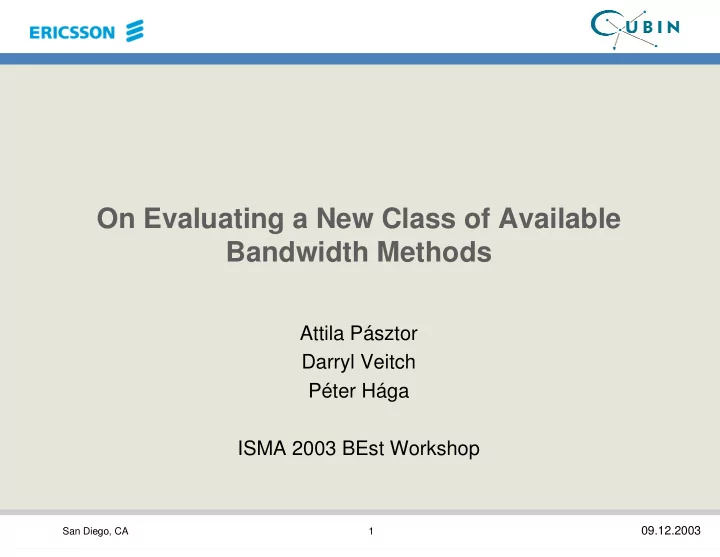

On Evaluating a New Class of Available Bandwidth Methods Attila Pásztor Darryl Veitch Péter Hága ISMA 2003 BEst Workshop 09.12.2003 San Diego, CA 1
Outline • A new class of active probing methods: the ‘Interaction class’ • A methodology to evaluate, compare and develop active probing methods • Some results • Ongoing work and future plans 09.12.2003 San Diego, CA 2
Fundamental Network Effects • Two fundamental network effects identified in the literature as the bases of existing probing techniques – Spacing effect • bottleneck spacing determining the inter arrival-time to the receiver • assumes probes being in the SAME busy period at the link of interest – Accumulation effect • packet size dependence of service time • assumes probes being in DIFFERENT busy periods at all hops 09.12.2003 San Diego, CA 3
Spacing Effect t= p/ µ µ µ µ b 09.12.2003 San Diego, CA 4
d 1 - d 2 =(p 1 - p 2 ) Σ Σ i ( 1 / µ µ i ) Accumulation effect Σ Σ µ µ 09.12.2003 San Diego, CA 5
Existing Bandwidth Estimation Methods • Packet Pair and Packet Trains – Spacing effect based – Probes of the pattern in the same busy period • One Packet Based – Accumulation effect based – Well separated, independent probes • Hybrid – Based on spacing and accumulation effects – Some probes of the pattern are designated to be in the same busy period, some to be separated ������������������������������������������� 09.12.2003 San Diego, CA 6
Existing Bandwidth Estimation Methods • Other methods – the ‘Interaction class’ – Based on the interaction of cross traffic and probes – The cross traffic determines which probes of the pattern join the same busy period – The focus of these methods is to detect when and which probes join the same busy period, to detect the transition from an independent system to a linear system ��������������������������� 09.12.2003 San Diego, CA 7
Methods of the ‘Interaction’ class • TOPP (Melander et.al) • Pathload (Dovrolis et.al) • Pathchirp (Ribeiro et.al) • ‘(Poly)Chirp’ • ‘(Poly)S(moothed)chirp’ 09.12.2003 San Diego, CA 8
Methods of the ‘Interaction’ class • TOPP (Melander et.al) • Pathload (Dovrolis et.al) • Pathchirp (Ribeiro et.al) • ‘(Poly)Chirp’ • ‘(Poly)S(moothed)chirp’ 09.12.2003 San Diego, CA 9
Methods of the ‘Interaction’ class • TOPP (Melander et.al) • Pathload (Dovrolis et.al) • Pathchirp (Ribeiro et.al) • ‘(Poly)Chirp’ • ‘(Poly)S(moothed)chirp’ 09.12.2003 San Diego, CA 10
Transition from an Independent System to a Linear System 09.12.2003 San Diego, CA 11
Transition – Key to the Other Methods 09.12.2003 San Diego, CA 12
Transition – Key to the Other Methods ��������������������������������� �������������������������������� �������������� ��������������������������� �������� 09.12.2003 San Diego, CA 13
The Key Elements of ������� Active Probing Methods 09.12.2003 San Diego, CA 14
Problems of Studying Active Probing Methods ������� • The Network is typically – not fully known, neither the background traffic, nor the topology – not under our control ���� ������� • Consequences: – difficult to verify the results �������� ������� – hard to repeat the experiments ������� ������� – problematic to reliably compare different methods 09.12.2003 San Diego, CA 15
Studying Active Probing Methods ������� ��������� • The Simulated Network is ������� – fully known, including the background traffic and the topology – “fully instrumented” – fully under our control ���� ���� ������� ������� • As a consequence it is easy to: – verify the results �������� �������� ������� ������� – repeat the experiments ������� ������� ������� ������� – reliably compare different methods • Essential to ensure, that the topology and background traffic is realistic 09.12.2003 San Diego, CA 16
PSIM - The Probing Simulator – High performance, tailored to the requirements of active probing – A multiple hop network model – series of FIFO queues and links – Inputs: • Route configuration • Cross traffic entering at different hops • Probe stream injected – The output is the probe arrival time series to the intermediate hops and to the receiver, including information about probes being I/B • Calculated using the recursion relations of queueing theory – Accepts arbitrary cross traffic – generated synthetically or from real network traces – Compatible input/output formats with our active probing applications • Allowing easy switching between simulated and real network experiments 09.12.2003 San Diego, CA 17
An experiment using PSIM • We have integrated pathload into our framework • Compare it to our chirp pattern based AB estimation method • A two hop route - a100Mbps link followed by a 3Mbps link • A 30 min long cross traffic trace • Pathload is probing with 220 kbps average rate • The chirp based method is probing with 42 kbps rate 09.12.2003 San Diego, CA 18
09.12.2003 San Diego, CA 19
09.12.2003 San Diego, CA 20
09.12.2003 San Diego, CA 21
09.12.2003 San Diego, CA 22
09.12.2003 San Diego, CA 23
09.12.2003 San Diego, CA 24
09.12.2003 San Diego, CA 25
The proof of the pudding … • The simulation environment is not identical to the reality – SW and HW limitations of the probing equipment – Some properties of real networks may differ from the simulated model • Ongoing and future work: – Integrating pathchirp into our experimental framework – Study of the properties of the ‘interaction class’ – Development of a new standalone available bandwidth estimation application 09.12.2003 San Diego, CA 26
Chirp based probing 09.12.2003 San Diego, CA 27
Recommend
More recommend